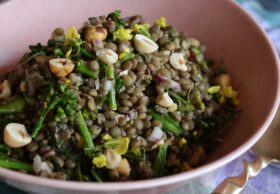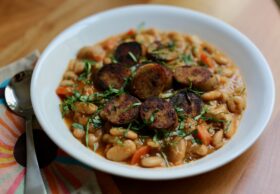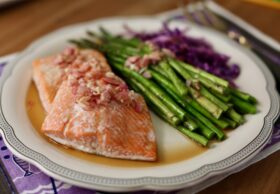Learn to Cook: How to Boil Eggs
Dear Friends, I have learned a lot about how to boil eggs since I made this video (in 2010!!) Visit this post for an easy-peel boiled eggs method. (It’s the only way I do them now.)
How to Boil Eggs
This is the fourth in a series of answer posts to reader-submitted questions. Some of these posts may be incorporated into the revised edition of the Learn to Cook book.
Hard boiled eggs might be one of the trickiest things to get just right. You want the yolks firm and centered with no green halo, whites cooked but not rubbery, and the easier to peel, the better. There are few things as frustrating as peeling boiled eggs and having the shell stick so tight to the egg that you end up removing half the white along with it, leaving your eggs looking like Bill Murray’s cheeks. For ease of peeling, get some eggs that aren’t the absolute freshest. You can just buy a dozen a week before you’ll boil them and leave them in the fridge, or check the dates on the ones in the store and find a dozen that are maybe a week or two out from the expiration date. The reason for this is that slightly older eggs don’t cling so tightly to the inner membrane and the shell will almost just slip off. So, there’s one problem solved.
For a video demonstration on how to boil eggs, check this out!
Or read along with these easy steps:
- Put the eggs in a pot and add enough water to cover them by at least 1/2″ and up to 1″ (Cook an egg or two more than you need in case one should break or be hard to peel.)
- Put the pot over high heat and stir the eggs gently every couple of minutes until it reaches a boil. Moving the eggs around as they heat will help keep the yolks centered and slowly bringing the water up to boil will prevent the shells cracking prematurely.
- Once it boils, put a lid on the pot and turn the heat off. Leave them in the hot water for 8-12 minutes, depending on how big they are. Large eggs, I’ll do for 10 minutes; extra-large for 12. Small and medium eggs are hard to find, but you get the idea. This method prevents the eggs overcooking, which is why you sometimes get rubbery whites and greenish yolks.
- While you wait, get a large bowl and fill it with ice and water.
- When the eggs are done, use tongs to move them carefully into the ice water. This sudden change in temperature is not only going to stop the cooking process, it’s also going to make peeling them a LOT easier.
- If you want to boil eggs ahead of time to eat through the week in egg salad or whatever, allow them to cool in the ice water for 10 minutes, then dry the shells. Mark with a “B” or something so you can tell the cooked eggs from the raw, then refrigerate and peel when you’re ready to eat. Boiled eggs will keep at least a week.
- To peel right now: let them cool in there about 5-10 minutes, then take them out one by one and gently tap them on the counter on all sides to crack the shells all over. Put the eggs back in the cold water as you crack them to cool more and let the water seep under the membrane to help peeling even more!
- Peel the shell and the underlying membrane off of each egg and refrigerate until you are ready to make deviled eggs! If you need to keep them over night, cover with a damp towel before refrigerating so they don’t dry out.
9 Comments
Leave a Comment









My mama did ’em just like you do… And yep, they turned out perrrrfect…but she always removed the egg shells under cold running water and they just slide right out of those little suckers! No time’a wasted with shell bits on th’ ‘ole fingers. 😉
Hi, Gina! I have no recollection of how my parents used to boil eggs, but I think they must not have done them this way because I remember the yolks were always really chalky and I didn’t like them. 🙂 Thanks for the running water tip, though! Makes sense!
Have you ever tried baking them? Preheat the oven at 350, cook them (muffin holder will work) for 30 minutes, then put them in a bowl, filled with ice and water, for 10 minutes….you’ll be amazed!
I have HEARD of this witchcraft, but never tried it. 😉 The muffin tin is a fantastic idea for holding them! Thanks, Dirk! I will try baking some eggs along with my next batch of cookies.
And I will try your recipe out!!
By the way, I thought you were ‘taking off’ a few days…you multi-tasker you!
love the videos, all of them, and thanks for the hard boiled egg tips…i notice the written portion, and the video portion differ slightly…any reason why? thank you, again!!
Hi Mosh! I didn’t notice a difference, where did you see it?
Hope you try this method for boiled eggs!
Hello Hilah…I have a cooking question. Always been told to rest meat after cooking to let the juices redistribute. But when I do this’ Say with a steak off the grill. I put the steak on a plate to let rest and all the juices run out!! Every time! What’s up with that?
Hi John!
It’s perfectly normal for some juices — 1-2 tablespoons — to release onto the plate while the meat is resting. Resting is important for the reason you stated; if you try to cut a steak while smoking hot, the juices inside are extra-fluid and much more quickly run out.
Rest your meat on a platter for 5-20 minutes depending on the size and type (ie steaks and chicken breast need less time and roasts ad whole birds need more) before carving. Save the juices that collect on the platter and from carving and pour those over the meat before serving.